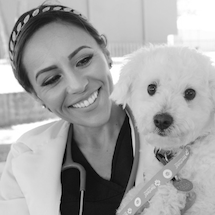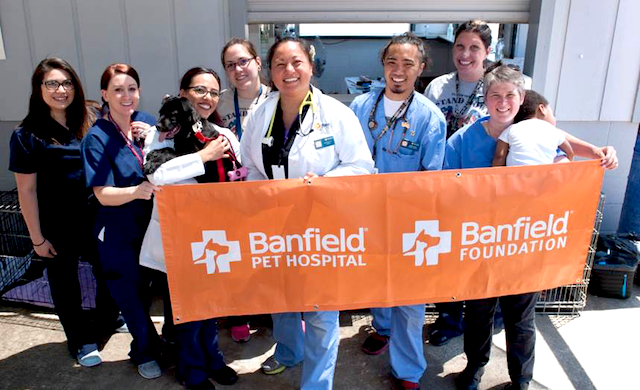
Helping Animals Brings Personal and Professional Rewards
11/14/2018 12:00AM | 4097 viewsAs she embarked on her quest to become a veterinarian, it seemed to Jovanna Radillo that she was behind from the start. She had to work her way through college, so she got a late start accruing the 3,500 hours of experience with animals needed in order to apply for veterinary school.
But she caught up and then some – and today she is the only person in California who has both a doctorate of veterinary medicine and a master’s in public policy and administration. That rare combination means that she can eventually work to bring non-profit veterinary services into low-income communities, or even lobby the government on behalf of veterinarians or for pet-friendly policies.
But for her the rewards are personal.
She remembers a patient, a cat named Lucy (her name has been changed), and the difficult decision she helped Lucy’s pet parents make when the time was right.
Lucy had a mass on her leg, which turned out to be an injection-site sarcoma – a cancerous tumor that can arise in cats after an injection. Her leg needed to be removed. Lucy’s mom understood and was on board, but her dad was against the procedure.
Dr. Radillo and her clients went back and forth for two months until both Lucy’s mom and dad agreed to do the removal. Sadly, a few months after the removal, the mass returned. The next steps would have been palliative care and oncology, but Lucy’s owners didn’t want to go forward with treatment.
When it was time, both Lucy’s mom and dad came in to consult Dr. Radillo. They told her they trusted her to know whether it was time to put Lucy to sleep or not.
“The mom said to me: ‘I know you’ll know,’” said Dr. Radillo. “We ended up doing the euthanasia. They were really thankful. They still bring their other babies to me.”
Dr. Radillo shared that story to convey the emotional part of the job that school does not prepare anyone for.
“We get taught in school how to work through cases,” she said. “But part of the emotional piece is not shared. You become part of the family. I didn’t expect that my role would have such a big impact on pet parents’ lives.”
Dr. Radillo always had a connection with animals and knew since childhood that she wanted to work with them in some way. In her junior year of high school, she decided to be a veterinarian.
She was accepted into University of California, Davis in 1999. Entering higher learning was a learning process for her in itself, because no one else in her family had gone to a larger university. She said she was lucky to get help and support from being part of a group called the Biological Undergrad Scholars Program.
“A lot of minorities aren’t as represented in science and technology, so they had a program to take additional classes to strengthen our skills in math and chemistry,” she explained. She recommends that all students look for similar programs, to seek any extra help where needed.
At that time, to apply for veterinary school prospective students needed to show that they had accrued 3,500 hours of working with animals in some capacity. While working on her undergraduate degree – a bachelor of science degree in evolution and ecology – Dr. Radillo couldn’t make much progress toward those hours because she had to work a regular job to pay for school.
Getting the Hours
To accrue the hours needed to apply for veterinary school, a lot of people start when they’re young. Some kids live or work on a farm, participate in 4H, or volunteer to help train guide dogs for the blind. There are also pre-vet groups or medical associations on some college campuses that will help you get the hours you need through various volunteer opportunities. You can also work or volunteer at an animal hospital or clinic, for small or large animals.
Dr. Radillo was able to get a few of her hours during her undergraduate years at UC Davis. Because the school has a robust animal science program, they have a working dairy farm and multiple labs and barns with llamas, sheep and pigs. Students can take classes that give them experience with animals, so Dr. Radillo took one that allowed her to work on the dairy farm.
But to get the bulk of her hours, she committed an entire year to it after she finished her master’s degree in public policy and administration from Sacramento State in Northern California. She had to put in about 3,000 hours in one year – that’s an average of 60 hours a week. Banfield Pet Hospital played a big role in helping her get her hours.
“I’m so thankful for Banfield,” she said. “I came in and got a job as an untrained nurse. Banfield is one of few who will hire you and train you as a veterinary assistant. I was able to learn a lot and get my hours. Everyone was really supportive.”
Seek Out Special Programs
Dr. Radillo applied to vet school through the Veterinary Medical Opportunity Program, which she described as a program for people with economic hardships. It’s a supplemental application on top of a veterinary school application. That extra application process includes a separate interview – a review with a panel of students and instructors. For Dr. Radillo that interview took place the day before her official veterinary school interview.
She said the program is especially useful if there’s something about your experience that you feel doesn’t make you shine. The program helps you explain those situations so you can present a full picture of your capabilities.
Dr. Radillo was glad to have a chance to explain that she had to work through college and therefore didn’t have the same experience with animals that other applicants might have.
“I was able to explain that there’s a reason why I couldn’t do the volunteering,” said Dr. Radillo.
Vet School – Getting In and Getting Through
You can get into veterinary school with any undergraduate degree, as long as you complete all of the pre-requisites at the university level. But with only 38 veterinary schools in the United States, it’s competitive.
Vet school is a four-year, full-time program. Dr. Radillo said that since it’s so hard to get in, once students are there, the schools do everything in their power to keep them as supported and successful as possible.
During the fourth year of school, students take the exam to become certified as a doctor of veterinary medicine. Those who pass can start general practice for small-, large- or mixed-animal veterinary medicine as soon as they finish school. Students who choose to specialize – in areas like anesthesia, dentistry, dermatology, emergency or others – continue their training after graduation with at least one year of internship and then a residency in their specialty.
To prepare for the personal and emotional side of the profession, Dr. Radillo recommends taking some undergraduate classes in communications and psychology.
“Those would be great additional tools to have before going to vet school,” said Dr. Radillo. “You learn a lot in school but there are things that you wish you had learned there, rather than on the job.”
Enjoying Your Day as a Veterinarian
On a typical day for Dr. Radillo, by the time she arrives at the hospital in the morning, the staff already has anesthesia for dental cleanings ready to go. She usually does surgeries in the morning, depending on what’s needed, then afternoons are typically full of patient visits and drop-offs.
“It’s a busy, fast-paced environment,” said Dr. Radillo. “There’s a mix of cases – it’s not all just puppies and kitties. There are some challenging cases, when someone needs a referral to a specialist but the client can’t pay for that. And there is a lot of communication – way more communications than I thought.”
The hardest part for new grads, she said, is that you have a lot conversations about what a pet needs but, in the end, the people can’t or won’t pay for the treatment.
“A lot of us are empaths,” she said. “We feel bad for the pets. We take on that guilt. But we have to remember that the clients are ultimately the ones driving the decisions. We pour our hearts out more than anything.”
She said it’s an emotionally draining job, but also is emotionally rewarding.
“When you see patients doing really well and they had been really sick but they came back, and when you build that bond with pets and clients. It’s awesome building that trust with a client.”






Post your Comment
Please login or sign up to comment
Comments